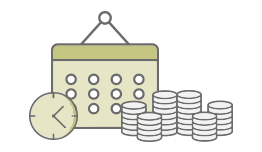Portfolio Management Service
Keeping track of your assets, investments, and savings takes a certain amount of dedication to ensure that they produce healthy returns that either meet or exceed your expectations. Credencis schematically assess each individual client to create a concise overwatch plan that enables advisers to keep things moving towards the agreed goals.
How we manage your portfolio
At Credencis we understand that everyone is individual.
Through in-depth fact-finds and risk questionnaires, we get to know your circumstances, understand your aspirations, and help you think about your attitude to risk. This means that the investment portfolio we build is individual to you and aligned to your long-term goals.
We review your investments regularly to ensure they are on track and will rebalance them if needed. Our hard work doesn’t stop at retirement either. We can help you manage your invested funds through both the accumulation and the decumulation phase of your retirement.
Pre-Retirement
Understanding your attitude to risk
The years leading up to your retirement are the “accumulation phase”. With your goal still some years away, you might consider taking a higher amount of risk, building up returns that can be consolidated as you approach retirement.
We will work with you, helping you to build the right portfolio for you. Before we can do that, you’ll need to think about these three important questions:

What are your long-term goals?

What timescales are attached to these goals?

What is your attitude to risk?
The answers to these questions will be strongly linked.
Your goal is your desired lifestyle in retirement, and only you know what that looks like. Your retirement date dictates the length of the investment and the further away that is, the more risk you might be willing to take.
Building your portfolio
A successful investment strategy focuses on attaining your goals. That doesn’t mean chasing large, high-risk returns, and we won’t expose your funds to risk unnecessarily.
The investment portfolio we build for you will comprise a mixture of equities, cash, and fixed-interest bonds. This is your “asset allocation” and each asset class carries its own level of risk.
Government bonds, for example, are effectively loans to the UK government and are considered low risk, whereas shares might be medium or higher risk.
Asset allocation is a type of diversification that we use to spread your investment risk, protecting your money from a fall in one asset class by offsetting it against a potential rise in another. The asset allocation we choose will be based on your individual profile.
We diversify your portfolio in other ways too.
By investing your funds in different sectors and industries, and in different parts of the globe, we spread your investment risk further. A fall in value for one sector or region won’t necessarily mean a matching fall in your investment because rises could be occurring elsewhere.
By getting to know you, your circumstances, and your aspirations, we at Credencis can build a portfolio that aligns with your attitude to risk and that is designed specifically to achieve your long-term goal.
Managing your portfolio
Stock market prices are changing all the time. That is why we conduct regular reviews, ensuring your investment is still on track.
While your portfolio might start with the “optimum mix” for your circumstances, rises and falls of the market can shift it off balance. Whether the shift is caused by assets gaining or losing value, it is important to remain focused on your investment goal and that might mean rebalancing.
If your portfolio contains 70% equities and 30% bonds, for example, any rise or fall across the markets that alters this balance will need to be addressed. This might mean selling some assets that are performing well, to buy more of an asset that is currently undervalued.
Rebalancing isn’t about achieving higher returns but keeping you on track over the long term.
Post-Retirement
Consolidating your gains
If reaching your retirement date feels like summiting a mountain, you’ll want to enjoy yourself and celebrate the achievement. It is important to remember though, that the descent can be just as – if not more – perilous than the climb.
As your retirement nears, your capacity for loss will decrease. We recommend a lengthy investment period because it allows time for short-term market blips to level out and your funds to recover. The general trend of the markets is an upward one, but short-term downturns will happen.
As your retirement date approaches, you have less time to recover from a fall in value, and the impact of that fall will be greater.
For this reason, we will look to consolidate your gains as your retirement nears, moving your investments into lower-risk funds. You might be opting for a retirement option that leaves some funds invested. Although this allows for continued growth, it is also crucial that those funds are not exposed to undue risk and that they are there to draw from when you need them.
Managing your retirement income
Managing withdrawals once you retire is difficult. Like the descent from a mountain, there are lots of things to think about, and it’s important not to get complacent.
You might have a withdrawal amount planned – a percentage that you believe is sustainable throughout your retirement. But remember that there are no “golden rules”. Many factors can influence how long your money lasts and that is why our job doesn’t stop once you retire. We will remain on hand to guide you.
You’ll need to factor in:

Your life expectancy

Stock market movements

Inflation
As life expectancies continue to increase, it is important to consider how long your retirement will last. It is feasible that you will need to budget for a 30- or even a 40-year retirement.
The stock market is in constant flux and this could impact your retirement fund. Your unused amount might not see the returns you expected, and the amount you can withdraw will be affected too.
If you opt for flexi-access drawdown, remember that when the market is low you will need to sell more units to attain the same amount of income. This can deplete your fund more quickly than anticipated.
Also, be wary of drawing down more than you need. You will likely hold the excess in cash but, with savings rates low, these funds could lose value in real terms due to the effects of inflation.
We will help you manage your portfolio throughout your lifetime, ensuring you stand the best chance of achieving your retirement goals and that your income in retirement lasts. We can even help you consider the amount you would like to leave behind.
Need Advice? We can help.
If you need advice or more information concerning pensions, please get in touch.
